

 forest rights, conservation and dilemmas of growth
forest rights, conservation and dilemmas of growth
 © mazoomdaar 2011
© mazoomdaar 2011

The great iron ore heist
The Posco project in Orissa is not just about violation of people’s rights and a green disaster. It is easily the biggest loot
of India’s natural wealth. It is also the most brazen example of how the country’s who’s who are colluding to mock the
rule of law
Jay Mazoomdaar | June 16, 2011 | Abridged in OPEN
East India Company pori Posco amo oopore shaasan koriba payeen
ethare aasi pahanchichhi (Like the East India Company, Posco has
come here to rule over us).
More than a hundred armed police personnel lined up on the
narrow Balitutha bridge that connects the proposed Posco site to
the rest of the state. Less than a hundred yards away, around a
thousand angry villagers stood ground. They rallied here, man and
woman, from the affected villages to protest the land acquisition
drive, under the banner of Posco Pratirodh Sangram Samiti (PPSS).
This was May 18. The day the state government resumed the land
acquisition process, nine months after it was put on hold by
Environment and Forests minister Jairam Ramesh in August 2010.
Two weeks ago, Ramesh lifted the stop work order. Soon, the forces
marched in with revenue officials.
As six families surrendered betel vines for cash compensation in Polang village some 15 km away, animated Left leaders addressed a
rally at Balitutha. CPI-M state secretary Janardan Pati dared the administration to risk a bloodbath, and his CPI counterpart Dibakar
Nayak vowed not to allow Posco to do an East India Company in Orissa. It was past noon, temperature scaling the 44 degree mark, and
not a shade in sight. But a reflexive crowd roared in response.
Two days ago, at a four-bench roadside eatery in Erasama, around 20 km from Balitutha, Tamil Pradhan was wolfing down a very late
lunch. Vice-president of the United Action Committee (UAC) and the most visible face of the pro-Posco community leadership,
Pradhan had just finished a marathon meeting where the UAC placed six conditions before the district administration for land
acquisition.
As his cellphone rang incessantly, Pradhan sounded naively confident that the administration would not resume land acquisition
without taking the UAC into confidence. “Let them first decide on our demands. They need our support against the PPSS to enter the
area.”
“We are not for or against any factory,” he thundered between two fistfuls of rice. “People did not invite Posco here. So if they want the
factory, they will have to give people their due. But all these anti-Posco elements have selfish agendas. Soon after the MoU (between
the state and Posco) was signed in 2005, (CPI leader) D Raja came here to back his party cadres and attacked Posco as a blacklisted
multinational, equating it with the East India Company.”
In six years, the rhetoric has not changed. But the fate of this Rs 52,000-crore FDI cannot be decided on rhetoric but hard facts. And
hard facts tell a damning story that rarely surfaces above the media log of the many dubious milestones of this prolonged back-and-
forth.
THE PASS
From Noida in Uttar Pradesh to Jaitapur in Maharashtra, land acquisition is always an emotive issue. So much so that the collapse of
the Red bastion in West Bengal is being largely attributed to the Left’s disastrous bid to take over land for industry. Posco’s case is still
more sensitive. Since 3,097 hectares out of the 4,004-acre proposed Posco project area is classified as forest land, Posco required
environmental clearance for land diversion.
Standing on Balitutha bridge, however, one cannot spot any trace of forest in the horizon leading to the bay of Bengal. While the pro-
Posco camp contests the forest land status, pointing out that people here got farming loans from the government in the early 1980s,
those opposed to the steel plant furnish British records dating back to 1928 to claim how the area was always recorded as “dense
deciduous forest where people grew betel”.
The forest has disappeared since. Betel vines, arguably the country’s finest, and paddy fields have taken over much of the land. So in
August 2008, the Supreme Court offered “in principle” clearance for diversion of “forest land” for the Posco plant, hinging it on the
MoEF ensuring compliance to all relevant laws.
The Forest Rights Act (FRA) had come into force in January 2008, empowering forest dwellers to determine the nature and extent of
land use for non-forestry work. Another year passed in protests and rhetoric. Meanwhile, the UPA was re-elected to power and Jairam
Ramesh took over as minister of environment and forests. In August 2009, he ordered that no application for land diversion for Posco
could be made without the consent of the gram sabhas affected.
On record, not a single paper moved in the next five months between the state and the MoEF regarding the consent of these gram
sabhas. Yet, Ramesh granted the “final clearance” for land diversion on December 29, 2010, in violation of his own August 2009 order.
But following nationwide outrage, the minister had to issue a clarification in 10 days flat. On January 8, 2010, he wrote to the state
that “final clearance” was “conditional” on settlement of rights under the FRA.
What followed was surreal (See Shame). Ignoring the resolutions passed by the gram sabhas, Orissa claimed that there were no tribals
or traditional forest dwellers in the project area. In the months to follow, two government-appointed committees –under N C Saxena
and Meena Gupta – nailed the state government’s lies. Following the first report that questioned the implementation of the FRA, the
MoEF stopped land acquisition in August 2010. Based on the second report – that called the state’s claims “false” and “fabricated” --
the Forest Advisory Committee (FAC) on November 19, 2010, recommended temporary withdrawal of the forest clearance.
Ignoring these recommendations, on January 31 this year, Ramesh offered yet another “conditional” final clearance. The project was on
if the Orissa government could give an “assurance” that there were no “eligible persons” for FRA in the area. The state government sent
the “assurance”, repeating all the claims earlier trashed as “false” by the government inquiry panels.
Meanwhile, village Forest Rights Committees had filed a complaint with the MoEF and passed fresh resolutions, rejecting consent for
diversion of land. Ramesh sought the state’s response to these resolutions. The Orissa government on April 29 termed the palli sabhas
illegal, the resolutions fake, and said the sarpanch had “overstepped the jurisdiction vested in him and misutilised his official
position”.
So on May 2, keeping “faith…in what the state government says”, Ramesh accorded the final approval for land diversion, adding some
safeguard clauses (See Safety myths). To cover his back, the minister added that he expected that the state would “immediately pursue
action” against the sarpanch for what it categorically said were “fraudulent” acts, and, “if no action is taken forthwith, I believe that the
state government’s arguments will be called into serious question.”
Sisir Mahapatra, sarpanch of Dhinkia, was suspended on May 27 but no case has been filed against him yet. Mahapatra says he will
move the Orissa High Court to contest the suspension.
THE POLITICS
After his hurried lunch, UAC’s Tamil Pradhan blamed an Indian
steel giant for fuelling the anti-Posco movement and drove away in
a silver Indigo to his house in Nuagaon to freshen up before
dashing off to a TV studio in Cuttack. Pradhan’s neighbour, UAC
chief Anadi Raut, is a retired headmaster. He orders a cold drink
on his terrace and sounds quietly confident: “We are giving
conditional support to Posco. So they (Posco and the
administration) have to accept our terms because these PPSS
people oppose the plant unconditionally.”
Raut’s brother-in-law Dr Damodar Raut is a Biju Janata Dal
veteran. An inter-party power tussle recently cost the MLA from
Erasama the agriculture portfolio. Many credit Dr Raut with the
pro-Posco UAC movement but he is sulking: “From 38 per cent in
1948, Orissa’s forest cover is down to 14 per cent. All our forests
are being mined. We need land for agriculture but we are blindly
going for industry. The state has signed 49 MoUs for steel plants and another 27 for power.”
But wasn’t he the man chief minister Naveen Patnaik entrusted with breaking the anti-Posco resistance? Dr Raut nods grimly: “Yes, the
CM asked me to use my good offices to reach out to the affected villagers. We made good ground. But now I am keeping away as things
have taken a different turn. The Posco MoU expired last year. How can the state acquire land without renewing the MoU, without a
proper rehab package?”
PPSS spokesperson Prashant Paikray finds Dr Raut’s “new stance” amusing. At his modest Bhubaneswar home, he goes through his
media routine and furnishes every detail to prove that villagers in the project area met all conditions to be eligible under the FRA
(see Rights wronged). Asked if the PPSS was indeed sponsored by Posco’s competitors, as alleged by UAC’s Pradhan, Paikray laughs.
He cut his teeth as a rights activist in Gopalpur, he recalls, fighting Tata Steel’s SEZ project. Then he goes back to his media routine
again.
On way to Balitutha, hollow faces stare at outsiders from a small refugee camp by the road. This is Posco Transit Camp where around
50 families stay put in one-room tenements under tin roofs, sharing nine “common” toilets. They are from Patana, a Dhinkia
neighbourhood, the heart of the anti-Posco resistance. In June 2007, they apparently refused to vote for the Left candidate backed by
the PPSS. So they say they were tortured and driven out of the village.
Like his neighbours in Dhinkia, Narahari Mohanty used to make Rs 10-12,000 a month from his betel vines. Now he has converted a
window of his sweltering, one-room hutment into a stationery shop that does not sell items worth Rs 20 a day. “Who will buy? We have
become paupers overnight,” he rues. Mohanty has seven family members to feed and the Rs 600 monthly refugee allowance has not
been coming for three long months. The camp youth gather around silently. Sangram Parihar says none of them has a job. Do they
regret supporting Posco? Parihar turns away and whispers to his friend Santosh Mohanty who decides against confiding in a stranger.
In Dhinkia, roads are the obvious casualty. No government agency could enter the village in years, not even the PWD. Off non-existent
roads, it takes a kilometre’s walk across sand dunes from Gopalpur to find CPI leader Abhay Sahu, who controls the PPSS, in a
casuarina grove. His siesta interrupted, Sahu takes questions lying on a cot under a cashewnut tree.
“Why even bother to term our gram sabhas illegal and signatures fake if we don’t qualify for the FRA? They (administration) had to lie
because they know that people are living here for generations. Okay, our gram sabha is illegal, but where is the legal gram sabha? They
say we (the PPSS) misguide people. why don’t they hold a free and fair gram sabha with independent observers and take a vote?” Sahu
smiles like a man in control.
So who funds the PPSS? Sahu says many organisations support them in solidarity. Besides, every villager contributes one rupee per
betel plant – not much, explains Sahu, considering a single betel leaf fetches the same in the market. But is the PPSS coercive? Sahu
frowns: “If you are talking of those families who were paid by Posco to conspire against fellow villagers, I will say people have shown
restraint to let them leave the village unharmed.”
With the same panache, he dismisses charges that he has too many properties to his name for a fulltime politician. “These charges
make me more famous,” Sahu’s smile returns. He smugly informs that he carries on 46 court cases, his wife has a government job and
his sons are both engineers. Then he excuses himself to prepare for the next day’s big rally against a possible resumption of land
acquisition.
THE GROUND
The next day, May 18, as forces lined up to take on a possible PPSS
onslaught at Balitutha, Nuagaon sarpanch Bhaskar Swain was busy
weighing out flour in his grocery shop. Both the PPSS and UAC
leadership winced at the mention of his name. Swain was candid
that he switched sides frequently: “I found that both sides have
vested interests. The UAC only want good deals for their members.
The PPSS has a political agenda. I want every villager to benefit.
For that, all three panchayats should sit together.” Swain poses for
a quick photo before returning to the waiting customers.
At Balitutha, additional superintendent of police (Paradip) SK Das
said he has enough reserve forces to deal with the PPSS rally if it
“turns ugly”. Given the charges of police atrocities in the past, did
presence of the media worry him? Das sounded philosophical: “We
are not demons; we do not use force on peaceful protest.” Soon, the
PPSS rally stopped a hundred metres short of the police formation, roared to fiery speeches by its leaders, and dispersed in a few
hours. A relieved Das waved at a few friendly press photographers as they drive back.
Things remained largely peaceful during the next week as the administration acquired land from villagers “willing” to accept cash
compensation. But the “willing” were few and soon the forces joined the action. People, among them elected gram panchayat members,
were forced to accept “compensation” and even detained if they resisted destruction of their betel vines.
So, at the heart of anti-Posco resistance, villagers of Govindpur and Dhinkia put up human barricades. Under a scorching sun,
children and women of Govindpur and Dhinkia villages lay on roasting sand to form two human rings, blocking approach roads.
Unable to persuade the defiant villagers, the team sneaked in from the seaside on June 11. The daily bulletin proudly proclaimed that
the government had taken over 24 betel vines. What went unreported: villagers rebuilt the vines the next day and women and children,
back to take turns under the sun.
The miffed UAC leadership, meanwhile, has been reined in by the administration with an assurance that its demands will be considered
soon (much to the relief of Pradhan, who besides his UAC commitments, now has to take time out for the ongoing Orissa Premier
League, an IPL-format Twenty20 cricket tournament in which he has “some stake”).
As the battle of nerves intensified in Govindpur, villagers moved a PIL in the Orissa High Court on May 20 for a stay on the land
acquisition. The next hearing is on June 20. National Board for Wildlife member Biswajit Mohanty also moved the high court against
the state for allotting ports to private parties through direct negotiation, without inviting public bids as mandated by the Centre. While
the petition will be heard again on June 21, an interim order on May 30 barred the state from signing any MoU for private ports
without the court’s permission, in effect, stalling Orissa’s plan to ink a fresh MoU (the one signed in 2005 expired last year) with
Posco.
THE LOOT
While India pats itself on netting the single largest FDI, Posco is
poised to make many times its investment from iron ore only. The
2005 MoU allows the Korean company to extract 600 MT iron ore
over 30 years. Orissa’s 2004 MoU with Tata Steel allowed
extraction of just 250 MT ore for a 6 MTPA steel plant at
Kalinganagar. Clearly, Posco got to extract an extra 100 MT ore for
its 12 MTPA plant.
Why does Posco need so much iron ore? Because the company
always wanted to export ore (10 MT per year) and the 2005 MoU
allows it to ship out 30 per cent of the ore it extracts. In fact, the
2005 MoU also concedes that Posco may source an additional 400
MT of iron ore from India for their steel plants in Korea through a
long–term supply arrangement from the open market. There is a
fat margin between the domestic open market (average Rs
4400/tonne) and the international price (average Rs 7400/tonne) of iron ore. For 400 MT, it adds up to Rs 1.20 lakh crore.
Posco gets this deal at a time when the national consensus is moving towards limiting iron ore export to help the domestic steel
industry. India is the world’s largest iron ore exporter after Australia and Brazil. But in terms of per capita reserve, India has only 21
tonnes of iron ore against Brazil’s 333 tonnes and Australia’s 2000 tonnes. Various studies have estimated that business-as-usual will
exhaust Indian’s iron ore reserve anytime between 2025 and 2040.
Karnataka banned iron ore export in 2010, Chhattisgarh is considering the option and Orissa chief minister Naveen Patnaik’s own Steel
and Mines Minister Raghunath Mohanty floated a similar proposal this January. Even Ramesh, while issuing the final clearance to
Posco on May 2, hoped that “the new MoU would be negotiated by the state government in such a way that exports of iron ore are
completely avoided”.
Exports apart, the financial implication of subsidising 600 MT iron ore for a multinational is grave. The state governments earned a
paltry Rs 27 per tonne till the Centre fixed 10 per cent of the domestic market price (Rs 4,400/tonne for high quality ore in Orissa) as
revenue in 2009. The same iron ore fetches an average price of Rs 7400 in the international market. Discounting for royalty and
operation cost (mining, freight etc), the margin stands at around Rs 6,200 per tonne.
So, if Posco bought the allotted 600 million tonnes of ore in the international market, the company would have to shell out an
additional Rs 3.72 lakh crore. That is India’s gift to a Korean competitor, a scam much bigger than the 2G mobile spectrum allocations
worth around Rs 1.76 lakh crore. Even if Posco bought the same quantity of ore at the domestic price (average Rs 4400/ton) for the
Orissa plant, it would still have to spend an extra Rs 1.92 lakh crore. And, iron ore price will keep soaring. It has risen by more than
500 per cent in the past 30 years.
Obviously, Indian buyers will have to pay international price for steel from Posco’s Orissa plant. Besides, the Posco project got an in-
principle approval as a Special Economic Zone (SEZ) in 2006. The SEZ status means that the Centre and the Orissa government will
have to forfeit bulk of the projected revenue of Rs 89,000 crore and Rs 22,500 crore, respectively, as tax sops.
Moreover, Posco’s SEZ status (read free export zone) and the captive port will make it very difficult for the authorities to keep a tab on
how much ore Posco ships out from its exclusive facilities. Since the government levies no export duty in SEZs, it will also be much
more profitable for Posco to export its steel produce from Odisha than to sell it in the domestic market.
Not all developing nations dump their national interest so casually. Posco tried the same deal in Brazil in 2004 when it inked a pact
with Companhia Vale do Rio Doce (CVRD) for setting up a steel plant at the port city of Sao Luis and sourcing cheap ore from the
Carajas mine. But CVRD not only insisted that Posco buy ore at market price but also hiked the 2004 price of ore by 71 per cent in
2005.
So Posco shifted focus to Orissa.
THE PLOY
Aware of India’s strict green laws, Posco, very methodically, first
broke down its mega plans into segments and then downplayed
each component to obtain clearances. The company’s controversial
acquisition of 4004 acres is for the port and the power-cum-steel
plant only. The project requires another 8100 acre land – 6,100
acre (mostly forest) for mining and 2000 acres for two townships
at the steel plant and the mine.
The proposal for the power-cum-steel plant itself is misleading.
The application for environmental clearance mentions a 4 MTPA
steel plant and not the 12 MTPA that will come up in just 6 years.
The environmental impact of the power plant was considered for
only 400 MW installed capacity and not the entire 1100 MW that
would follow.
The primary requirement of a steel plant: iron ore. Posco is yet to get permission to mine 6,100 acres of lush forest in Kandadhar Hills
to extract those 600 million tonnes of ore. On July 14, 2010, the state high court cancelled the out-of-turn allotment of mining permit
to the Korean MNC. In October, the state government moved the apex court against the HC order and the matter is sub judice.
The second key requirement: water. It is not clear if the approval for fresh water use of 10 million gallon daily (MGD) -- slashed from
the original approval for 16.5 MGD -- is meant for the 4 MTPA production level or the full 12 MTPA-level. In 2006, Posco got
permission to draw 125 cusec water from the Jobra barrage. Following protests by the Mahanadi Banchao Andolan, backed by the
Bharatiya Janata Party, the state asked Posco in September 2010 to draw water from Hansua river instead. While the company has
commissioned a fresh feasibility study, the issue remains unresolved.
Without any certainty on securing ore and water, Posco has frog-leaped to acquire land for its plant. And the final component – a port
to ship produce – is the first unit they got cleared; but again, not without doctoring facts. The captive port was proposed as a minor
port to escape the stringent reviews that major ports attract. But the Posco port will construct two massive breakwaters – one 1070-
metre-long to the north and another 1600-metres-long to the south – to control turbulence. There will be a 13-km-long approach
channel, with a minimum width of 250m, to allow 170,000 DWT ships, among the biggest in the business.
Clearly, Posco’s Orissa plot is larger than the sum of its parts. Getting started with the port and plant before obtaining rights to ore and
water is an attempt to force a fait accompli, a phrase Ramesh himself uses liberally to describe the Navi Mumbai airport, Jaitapur
nuclear plant or coal blocks across India.
Not that everyone was blind. In November 2007, the Supreme Court’s Central Empowered Committee (CEC) in its report noted that
“instead of piecemeal diversion of forest land for the project, it would be appropriate that the total forest land required for the project,
including for mining, is assessed and a decision for diversion of forest land is taken for the entire forest land”. In fact, the SC’s in-
principle approval in August 2008 to diversion of 3,093 acre forest land for the Posco plant shared these concerns.
But the MoEF was not listening.
THE PUSH
Ramesh’s leap of faith is not out of sync with the alacrity shown by
his predecessors in the green ministry in pushing the Posco
project. But were they under pressure from their bosses and
colleagues in the government?
Consider these:
•
In 2007, a file noting on May 8 shows the Finance Ministry
sought an update on the Posco project. The next day, a letter
from the Director, Disinvestment, wanted the status of the
Posco proposal to be sent to the Finance Ministry by May 18
as then Finance Minister P Chidambaram was meeting the
members of the Investment Commission on May 24.
Within days, a few hours before he relinquished charge at
the MoEF to take over Telecom on May 16, A Raja issued the
environment clearance to Posco port, probably the last of 2,016 green clearances he granted in just 36 months.
•
Again in 2007, a letter dated June 4 from the Finance Ministry sought the status of the Posco applications by June 11, for a
review meeting on the project’s progress was scheduled for June 16. The MoEF expert appraisal committee (EAC) cleared the
plant at its meeting on June 20.
The majority in the Meena Gupta inquiry committee noted that “the proximity of the dates between the letters from the Finance
Ministry and the hasty processing of the approvals by the MoEF and the EAC despite the serious shortcoming and illegalities is
more than a mere coincidence” and “the brazen interference of the Ministry of Finance into functioning of another Ministry is
most unfortunate, highly improper and against public interest”.
•
Meena Gupta took charge as MoEF secretary on June 1, 2007. Since Raja had already moved to Telecom, MoEF was effectively
under the Prime Minister’s Office. Posco had applied for port clearance in September 2006 and it took Raja eight months to okay
it. The application for environmental clearance for the Posco plant was filed on April 27, 2007. Under the PMO, Gupta issued the
clearance on July 19, in less than three months. Again, when the Orissa government sought clearance for diverting 3000 acre
forest land for the plant on June 26, 2007, Gupta promptly obtained an in-principle nod from the ministry’s FAC on August 9,
2007.
•
Could it be a coincidence that Ramesh handpicked the same Meena Gupta to head the four-member fact-finding committee in
2010? Unsurprisingly, Gupta was the lone dissenter in the panel and found nothing wrong with the clearance for land diversion
that she had issued herself.
•
Prime Minister Manmohan Singh, along with Orissa chief minister Naveen Patnaik, assured South Korean President Lee Myung-
bak about speedy clearance of the Posco project when the latter was in New Delhi as the chief guest for the Republic Day parade
last year. Minister of Steel Virbhadra Singh even offered a 6-month deadline for handover of land to the Posco delegation that
accompanied the Korean President.
Dr Singh repeated the assurance at the 17th ASEAN summit at Hanoi last October. During the G20 summit at Seoul last November,
India’s Ambassador to South Korea S R Tayal said there was “a common desire on both sides to see the project through” and “every
effort is being made by all stakeholders”.
It is surprising how the cream of the Indian administration, from the Prime Minister to an Ambassador, could offer personal
commitments on an issue to be decided on its legal merit. Evidently, the pressure on MoEF to clear the project before G20 was
enormous. After failing to meet the deadline, Ramesh blamed the FAC for delaying its report and assured the who’s who in the power
circle that “the decision will be taken within a couple of weeks”.
Eventually, it took Ramesh a few months to mock the FAC, sundry committees of his own making and the rule of law to clear Posco
with a lofty justification: “Beyond a point, the bona fides of a democratically elected state government cannot always be questioned by
the Centre”. But can the bona fides of a democratically elected gram panchayat be questioned any more than that of a state
government?
For the villagers of Dhinkia, it may be too late for an answer.
Mazoomdaar is an independent journalist








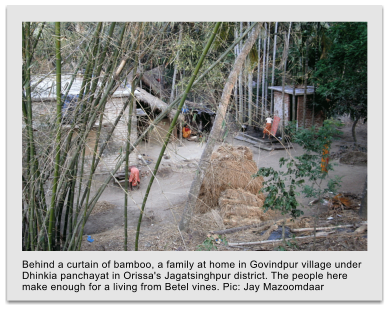
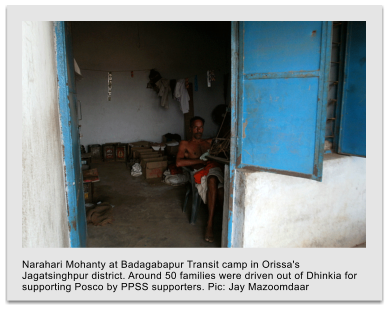
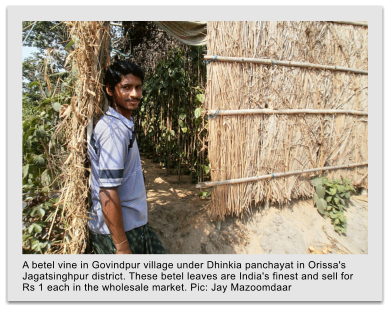
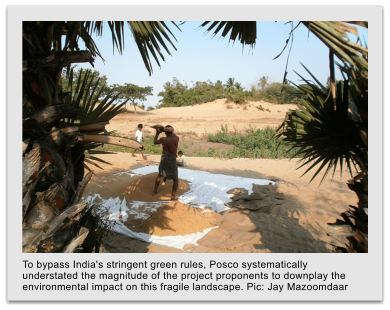
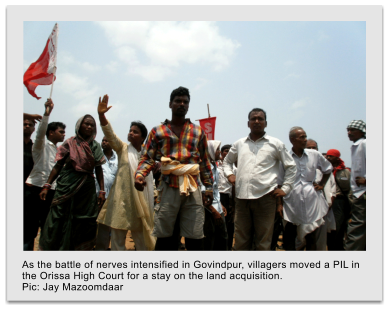 Home | Reports | Related Articles | Resources | Gallery | Feedback | Contact | About
Home | Reports | Related Articles | Resources | Gallery | Feedback | Contact | About



















 Home | Reports | Related Articles | Resources | Gallery | Feedback | Contact | About
Home | Reports | Related Articles | Resources | Gallery | Feedback | Contact | About














